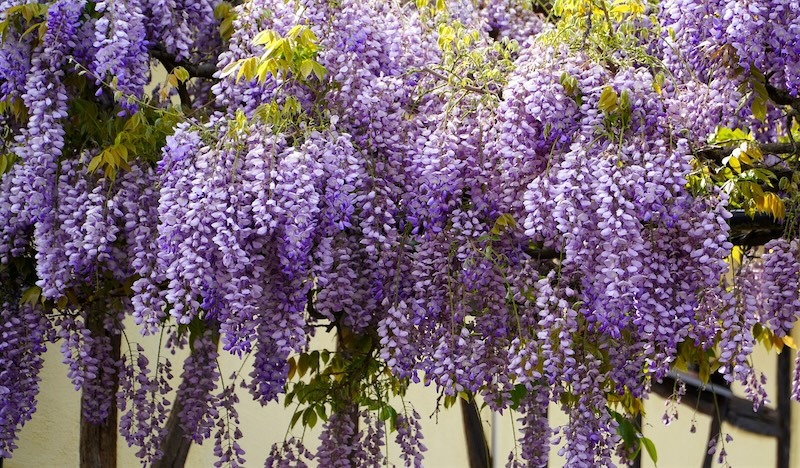Growing Wisteria
The reaching vines and fragrant raceme flowers make Wisteria a charming perennial to plant near a pergola, fence, or arbor. This plant climbs, so the twining vines need a supporting structure, but it is otherwise easy to maintain. The flowers come in shades of blue, purple, pink, and white. By fall, they develop into seed pods for added visual interest. The feathery pinnate leaves provide texture and give the plant a full and lush appearance.
Wisteria is a deciduous plant found in Asia and North America. This springtime flowering vine grows as a perennial in zones 5 through 9.

Planting Wisteria
Plant Wisteria in full sun. A spot with six or more hours of sunlight is ideal, although morning sun and afternoon shade are preferred in warm climates. Wisteria prefers well-drained soil that is slightly acidic to neutral. The thick vines become heavy with age, so provide a sturdy support. With time, the vines can engulf an arbor or trellis and develop a tree-like look.

Watering Wisteria
Water this vine consistently for the first few months. Young plants need routine water to develop a robust root system. Wisteria has average water needs once it has settled in. Water during an extended dry period, especially in the spring, to support the bloom cycle.
Fertilizing Wisteria
Fertilize Wisteria annually in the spring. Wisteria is a nitrogen fixer and naturally collects atmospheric nitrogen to suit its needs. Avoid fertilizers that contain nitrogen. Select a fertilizer high in phosphorus.

Pruning Wisteria
Prune Wisteria in late winter to rejuvenate the plant and encourage a full form. Be careful to leave flower buds on each vine so the plant will still bloom. Prune again in late spring or early summer after the flowers fade. The second pruning session is to tidy up the appearance and maintain a nice look. Remove wayward shoots or suckers.
Caring For Wisteria in Pots
Container-grown Wisteria needs full sun and water when the top half of the potting mix is dry. It should be fertilized once in the spring. Repot in the spring when the roots start to poke through the drainage hole in the container or if you notice growth has slowed.
Winter Care For Wisteria
Wisteria does not require special winter care. Although the leaves and seed pods will drop in the fall, the vine can stay as is without additional care. Apply a thick layer of organic mulch to insulate the roots and provide an extra boost of nutrition by spring.
